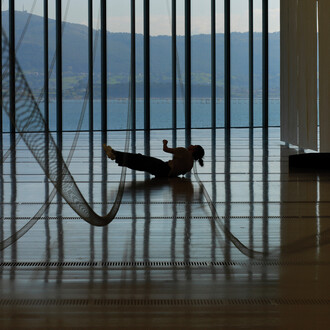Sabrina Amrani is pleased to present Sound objects; unsound times, Babak Golkar's fourth solo exhibition at the gallery.
The voice—and that visceral, primal energy of the scream—has all but lost its place today. To scream in the street is improper, online it dissolves into noise, and in intimacy it becomes emptiness. Yet the scream is one of our most elemental gestures: a tearing of the throat that demands, protests, liberates. It is the sound of refusal, but also the sound of pain. It is both protest and symptom. Where, and how, can one scream when every channel is co-opted, conditioned, or censored?
In 2012, Babak Golkar began his Scream pots, wheel-thrown clay vessels conceived as containers for the scream. Their creation emerged from a decisive gesture: an insistence that the viewer not only contemplate an object but complete it through action. This primordial move shifted the work from representation to performance, from artifact to device. The Scream pot is not fully realized until the breath falters, the diaphragm contracts, and the roar is surrendered to clay. It is at once vessel and instrument, object and script, a container for sound that both permits and neutralizes its release.
In Sound objects; unsound times, a single Scream pot is presented in the empty gallery space. Visitors are admitted one at a time, confronted with the vessel in solitude. This enforced isolation heightens the theatricality of the encounter: the gallery becomes a stage, the visitor a performer, the act of screaming both private and exposed. Without the buffer of the crowd, hesitation and impulse alike are amplified. What unfolds is less an exhibition than a ritual of complicity, where the silence of the room and the presence of the pot together frame the visitor within a system of vulnerability, surveillance, and self-disclosure.
The pot functions as both refuge and trap. It promises catharsis, yet enforces its own conditions. Like a microphone that magnifies but disciplines, or a digital feed that offers voice while neutralizing dissent, it embodies the paradox of our time: the more expression is encouraged, the more it is absorbed and contained.
Clay intensifies this contradiction. As earth, it is ancient and grounding; as vessel, it is fragile yet enduring. It absorbs sound yet refuses to release it. It is simultaneously open and closed, receptive and indifferent. In surrendering one’s voice to clay, the scream is both enacted and annulled—an echo that cannot escape.
The Scream pot insists that we inhabit this tension. At a time when collective cries vanish into the ether of screens and political systems, the act of screaming into a silent object resonates with fresh urgency. It is a promise of freedom exercised within the limits of containment, an intimate roar transformed into mute matter.
The invitation is simple: approach, hold the object, deposit your voice. No instructions, only impulse. Yet in that impulse lies the work’s force: a moment where protest and silence, freedom and regulation, catharsis and impotence meet. The scream, though muffled, exists. The voice, though contained, is uttered. And the act, though bounded, leaves its trace within us.













![Saul Steinberg, The museum [El museo] (detalle), 1972. Cortesía del Museo de Arte Abstracto Español](http://media.meer.com/attachments/dfbad16c22c5940b5ce7463468ac8879f3b4bf23/store/fill/330/330/042ecf3bcd2c9b4db7ddbc57cb32e950c095835f7b5cd55b6e1576a6e78c/Saul-Steinberg-The-museum-El-museo-detalle-1972-Cortesia-del-Museo-de-Arte-Abstracto-Espanol.jpg)


